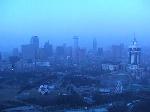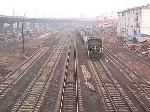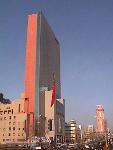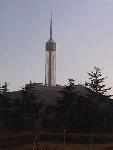- Getting around Lijiang. Dont stay in the Old Towns more than 2 days, there is nothing to do. KRISS Oct 9, 2013 05:46
- 2013 Beijing Temple Fair BENNYLAU Feb 26, 2013 03:29
- Malaysian traveling from KUL - LAX vis Shanghai PVG ZATI_DY Jan 3, 2013 20:15
Dalian Under Construction
- Views: 5998
- |Vote: 0 0
- |Add to Favorites
- |Recommend to Friends
***I lived in Dalian for two years, during which time many changes occurred. Dalian is now a thriving, modern city with many exciting attractions. However, the first time I visited, all those attractions were under construction, and Dalian was under a special period of transition. This is the story of my first visit there, which tells a lot of the sweet nature of traditional Dalian town. The places described here are still there, and more beautiful and developed today than ever before. ***
Train to Dalian
A seat on the slow train to Dalian city from Shenyang was just 28 yuan, and it seemed to make sense to economise after an expensive holiday in Beijing. So, on the morning of my trip, I forced my way onto one of China's famously overcrowded travelling classes, one of the many routes which are overbooked to a point that even if you have paid for a seat, you may not be able to fight your way to get to it.
Half an hour after the train left, I managed to squeeze into the cabin, having pushed and been pushed in the intercarriage compartment since getting on board. I was a nuisance to everyone with my enormous backpack: when the conductor finally asked for my ticket, she indicated that my seat was at the other end of the carriage and I'd have to shove my way there. My complaints in Chinese at least amused my fellow travellers. When I arrived at my seat, it was already occupied by a dark, stubbled, tired man with his infant son sleeping against his shoulder. He looked at me bashfully; neither of us wanted to wake the baby so I told him he could sit whilst I sat on my bag and read for the hour it took for us to arrive at his own small town, whereupon he vacated my seat with a gentle ‘thankyou’ in English.
The day was dry and cool, the Liaoning plains between the regular little city stops were mustardy with straw grass. I watched Anshan and Liaoyang pass by in the mid afternoon, sombre and blocky affairs which still evoked some charm; many of the less significant villages reminded me of Zhangjiakou. These wistful, industrial centres, the spiritedly dozy locals, dirt roads and faded cotton shirts.
A middle aged couple sat opposite me, with their small grandson. He was sucking enthusiastically on the neck of his two litre Sprite like it was a nipple; the sunlight through the green plastic on his cheeks looked like the spring regrowth of grass on the sides of the ochre mounts outside. His grandmother was teaching him the characters on the bottle's label, which I sadly noted that I myself was unable to read entirely.
Everyone had told me that Dalian was a spectacular city, even in Beijing. There, I'd distractedly picked up an English language newspaper one afternoon at Starbucks which contained a gushing article about it. Dalian is a seaside port right at the tip of the peninsula at the bottom of Liaoning. It's often termed 'Pearl of the North' or 'Hong Kong of the North' because of its modern skyline and lifestyle. It is wealthy, very clean, and, as the Starbucks article detailed, packed with fine examples of Japanese and Russian architecture - like Harbin, the city is a product of the struggle in Manchuria between Chinese, Japanese and Russian forces.
Dalian's story begins as a Chinese fishing village (Qing Ni Wa) which was taken by the Japanese in 1895 upon the recognition that the location was an ideal deep sea port - and, importantly - the only port in the area not obstructed periodically by ice sheets. It was a time when the Japanese were making moves throughout Eastern Manchuria - meanwhile, the Russians were coming down from the North, having taken advantage of their 'railway to Vladivostok through Harbin construction deal' with the Qing administration to justify their rather tyrannical occupation of the territory. They fought for and won the city in 1898, just after Britain had gained Hong Kong in the South of the country for similar reasons.
The Russians called the new city Dalny, and moved in promptly. It was beginning to look smart when the Japanese decided they wanted it back, and soon they were fighting over land that didn't strictly belong to either of them anyway. Their war was concluded by a treaty signed in Portsmouth, America, the States taking it upon themselves to award Dalny - and Shenyang too - to the Japanese.
Under Japan, Dalny became Dairen, and for forty years thrived as a Japanese trading and industrial zone. Development was rapid and pronounced, the city looked great and the population swelled accordingly - mainly Chinese labourers who knew the city as Lüta, but came to call it Dalian after the manner of the Japanese. Finally, the conclusion of the Second World War saw the Japanese out - Russia happily returned but were promptly booted by the Communists.
Now, after another fifty years, the city has become a major money maker for the whole Liaoning province: it's an open city, which means capitalism and foreign investment is allowed, it's attractive and by all reports the pride of the North. So, as the train pulled in to the station in the mid evening sea air beneath fresh skyscrapers and smart neon lights, I was in a pleasantly expectant mood, looking forward to taking the city in.
Dalian City
Dalian had made a favourable impression before I had even arrived, and walking through the inner city with my new guide Laura confirmed the rumours that Dalian is a metropolis of considerable appeal. The central business district is clean and developed, the atmosphere is fresh and the sea air is quick to disperse any significant smog caused by the burning of coal. Laura, a friend of one of my teaching colleagues who had organised an apartment for me in the city, was genuinely pleased to show off the layout of the downtown area and its surrounds, and at the moment I arrived she provided a meal and a quick orientation before helping me to my apartment.
I consider it to be critical, when trying to familiarise oneself with a new city within a limited timeframe, to walk as much as possible. Walking forces a gradual pace, it ensures that one is internalising the routes travelled and thus forming a mental representation of the city. When I met Laura again on Saturday morning, my immediate priority was merely to walk around the inner districts, and attempt to map in an adequate knowledge of the layout. It didn't prove difficult - Dalian is centred around Renmin Road, which stretches all the way from the city's hub in the East to the western zones. Renmin Road passes directly through the main public Squares, each with their own character.
The city's main square, Zhongshan Square, struck me as tacky, but was encircled by some superb architecture. Shenyang's Zhongshan Square sports a blocky statue of Mao, by contrast, Dalian's featured the latest Spring Festival installation, an imitation tree which looked like a sign that might be constructed over a pub; several cartoonish puffins nesting in its branches. There is an enormous television built onto one of the buildings across the road; in the evenings many locals can be found here watching crosstalk comedy or company-sponsored advertisements, or perhaps instructional ballroom or latin dancing videos.
Continuing West, Friendship Square has no park area, but is centred on a monument which characterises the World as a globe upheld by five geodesic hands, each coloured to represent the World's major races of humankind. It was unnervingly like a giant soccerball. Dalian is home to China's best soccer team, and soccer monuments are all over the city. Next was the People's Square, located around the government buildings, all of which resembled that beside Government Square in Shenyang. This was an open park; we wandered past kite flyers and bird feeders whilst installed loudspeakers played patriotic anthems about Dalian. From here, it was easy to see how spacious Dalian is, and how attractive the new buildings are. It also struck me how many of them appeared to be under construction. Laura informed me that I'd arrived in the middle of Dalian's reconstruction project.
Dalian is a city that is proud to be amongst China's most modern centres, but suffers in that its international reputation is still relatively slight. Dalian has until recently had no real tourist attractions; its cleanliness and modern skyline have been its only real drawcards, and these alone are not enough to make anything of a name for the city. Dalian's local government (widely praised within China) have recently initiated a series of development projects which intend to change this and make Dalian something of a major trade centre for the whole of Manchurian China.
It was low season, Winter was still hanging on and tourism (apart from me) was next to nonexistent. Thus were hotels closed, parks and attractions switched off, and a small army of workers building things on everywhere I wanted to see. Only Olympic Square, next up from the People's Square, seemed fully functional, a massive Olympic logo centred on China on a map of the world marked in the tiling; the soccer fields beside the enormous gym complex were in constant use, all day every day.
The TV Tower
Since arriving in Dalian, I had wanted to ascend the TV Tower. For a tourist, the problem is getting up to the top cheaply. Dalian's tower sits on a squat mount (of which there seem to be many in the city) behind labour park, and from the city centre it seems that the only simple way to get there directly is to pay the entrance fee for the park and take the gondolas to the summit. I didn't have time enough on this particular day (another late morning) to nut out a bus route from the map in Chinese I'd purchased, so I elected for this easy, if a little expensive, method.
Upon reflection, a taxi would have been cheaper, if less of a triumph. The park fee was ten yuan, I wandered past unusual plastic artworks which looked as if they'd been pulled from giant cereal boxes; a giant lantern, a huge soccer ball with statues of young boys kicking goals. The gondolas were forty; a slow ride facing the mount meant it was impossible to appreciate the view as I ascended without twisting my neck uncomfortably. I was in the lift to the top another thirty yuan later.
The windows at the top were so filthy that they were barely transparent, but the view was worth it. I was the sole visitor; I unfolded my map and filled in the gaps in my own mental picture of Dalian, worked out where the beaches and parks were. The sunset, ever my familiar travel companion, was spectacular over Bohai Bay, honeying the waves as the shadow of the tower traced out the roads beneath.
They had an Internet Café up there - email was expensive but I was keen for a coffee. Despite their conspicuous use of the easily recognisable Chinese characters for coffee, none was on offer, so I wrote for half an hour over a can of Sprite.
Back outside, it was getting dark and I noticed that the gondolas had closed. One of the attendants was still there, after a run of the standard questions about my country of origin, length of stay in China, and a commendation of my schoolkid Chinese, he broke the news to me that the only way back down was via the thrilling land sled ride constructed on the mountainside. My gondola ticket had already covered the fare, so I tucked in my jacket and squatted in the sled board, a plastic affair with a handle and wheel set that sat on a curvy metallic coaster slide. It was cold, the city was evening blued, and a silly foreigner with carrybag balanced dangerously on his lap sped down towards it on a twisting trail that seemed to poise itself before the view in celebration.







 Copyright © 1998-2025 All rights reserved.
Copyright © 1998-2025 All rights reserved.